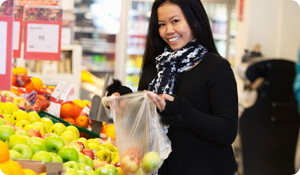
Food safety issues make headlines far too often. Even "healthy" foods like fruits, vegetables, and lean meats have been connected with serious illnesses caused by contamination with bacteria, parasites, and chemicals. This has many Americans wondering, "What's safe to eat?" The answer may depend on the quality of the foods you choose and whether or not you follow common sense safety-precautions. Here are five tips for bumping up the quality of your food.
1) Go SLOW (Sustainable, Local, Organic, and Whole)
Sustainable. Choose foods produced in ways that are healthy for consumers, animals, farms, farm workers, and the environment. Sustainable food is usually produced on small farms and in local, rural, and agricultural communities.
Local. Buy foods from farmers and gardeners who grow and sell their products as close to your community as possible. Local foods don't have to travel for days and miles to get to your market and are usually fresher than those produced in factories or on giant corporate farms.
Organic. As much as you can, choose foods that are produced without the use of synthetic chemicals, colors, pesticides, antibiotics, genetically modified agents, and irradiation.
Whole. Whole fruits, vegetables, grains, and nuts are always healthier than those that have been processed. Think apples instead of apple juice or whole wheat instead of white flour.
2) Get clean. Once you bring your fruits and veggies home, it's time to clean them up. Soil, natural fertilizers, and organisms can cling to leaves, peels, husks and skins, but gentle cleansing is usually all that's needed to make them safe to eat. You can buy veggie washes in the natural foods or produce section of your market or make your own:
- Add a cup of white vinegar and 1 tablespoon of salt to a sinkful of cold water. Soak your produce for 20-30 minutes. Pat or spin dry (use a salad spinner) and refrigerate.
3) Avoid the Dirty Dozen. Even if you can't always buy organic, at least try to buy organic (or clean extra thoroughly) whenever you purchase these products, which are considered the most potentially contaminated with pesticide residue:
- Peaches
- Apples
- Sweet Bell Peppers
- Celery
- Nectarines
- Strawberries
- Cherries
- Pears
- Grapes (Imported)
- Spinach
- Lettuce
- Potatoes
4) Go fishing. Some fish are at high risk for containing dangerous levels of mercury. Choose fish that are currently on the Environmental Defense Fund's "safe list" such as clams, cod, crab, halibut and haddock.
5) Meet your butcher. Instead of grabbing meats that have been pre-wrapped in plastic and from the cold-case, ask your butcher for cuts that come from local ranches and farms and that have been grass-fed, organically raised, and humanely treated. Asking where your meat comes from and purchasing from local, reputable suppliers is a good way to show your butcher that you care about quality and want to support local goods.
If a headline-making food is making you nervous, confirm with your grocer that it's recalled contaminated items. Then choose items you know you'll feel good about eating.
Source:
Environmental Defense Fund's "safe list"
http://apps.edf.org/page.cfm?tagID=15890





